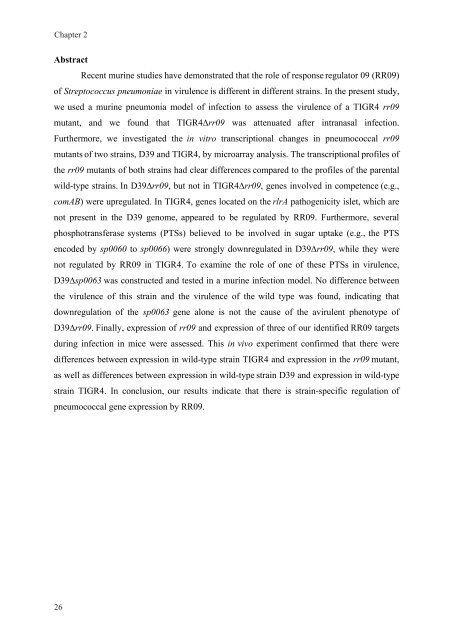Gene regulation in Streptococcus pneumoniae - RePub - Erasmus ...
Gene regulation in Streptococcus pneumoniae - RePub - Erasmus ...
Gene regulation in Streptococcus pneumoniae - RePub - Erasmus ...
You also want an ePaper? Increase the reach of your titles
YUMPU automatically turns print PDFs into web optimized ePapers that Google loves.
Chapter 2<br />
Abstract<br />
26<br />
26<br />
Recent mur<strong>in</strong>e studies have demonstrated that the role of response regulator 09 (RR09)<br />
of <strong>Streptococcus</strong> <strong>pneumoniae</strong> <strong>in</strong> virulence is different <strong>in</strong> different stra<strong>in</strong>s. In the present study,<br />
we used a mur<strong>in</strong>e pneumonia model of <strong>in</strong>fection to assess the virulence of a TIGR4 rr09<br />
mutant, and we found that TIGR4∆rr09 was attenuated after <strong>in</strong>tranasal <strong>in</strong>fection.<br />
Furthermore, we <strong>in</strong>vestigated the <strong>in</strong> vitro transcriptional changes <strong>in</strong> pneumococcal rr09<br />
mutants of two stra<strong>in</strong>s, D39 and TIGR4, by microarray analysis. The transcriptional profiles of<br />
the rr09 mutants of both stra<strong>in</strong>s had clear differences compared to the profiles of the parental<br />
wild-type stra<strong>in</strong>s. In D39∆rr09, but not <strong>in</strong> TIGR4∆rr09, genes <strong>in</strong>volved <strong>in</strong> competence (e.g.,<br />
comAB) were upregulated. In TIGR4, genes located on the rlrA pathogenicity islet, which are<br />
not present <strong>in</strong> the D39 genome, appeared to be regulated by RR09. Furthermore, several<br />
phosphotransferase systems (PTSs) believed to be <strong>in</strong>volved <strong>in</strong> sugar uptake (e.g., the PTS<br />
encoded by sp0060 to sp0066) were strongly downregulated <strong>in</strong> D39∆rr09, while they were<br />
not regulated by RR09 <strong>in</strong> TIGR4. To exam<strong>in</strong>e the role of one of these PTSs <strong>in</strong> virulence,<br />
D39∆sp0063 was constructed and tested <strong>in</strong> a mur<strong>in</strong>e <strong>in</strong>fection model. No difference between<br />
the virulence of this stra<strong>in</strong> and the virulence of the wild type was found, <strong>in</strong>dicat<strong>in</strong>g that<br />
down<strong>regulation</strong> of the sp0063 gene alone is not the cause of the avirulent phenotype of<br />
D39∆rr09. F<strong>in</strong>ally, expression of rr09 and expression of three of our identified RR09 targets<br />
dur<strong>in</strong>g <strong>in</strong>fection <strong>in</strong> mice were assessed. This <strong>in</strong> vivo experiment confirmed that there were<br />
differences between expression <strong>in</strong> wild-type stra<strong>in</strong> TIGR4 and expression <strong>in</strong> the rr09 mutant,<br />
as well as differences between expression <strong>in</strong> wild-type stra<strong>in</strong> D39 and expression <strong>in</strong> wild-type<br />
stra<strong>in</strong> TIGR4. In conclusion, our results <strong>in</strong>dicate that there is stra<strong>in</strong>-specific <strong>regulation</strong> of<br />
pneumococcal gene expression by RR09.

















